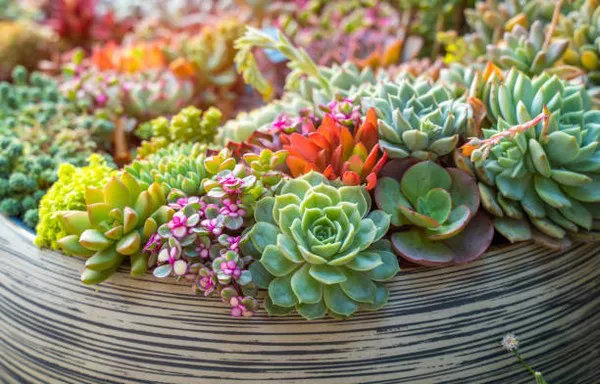Succulents have gained tremendous popularity in recent years due to their unique beauty and adaptability. However, these resilient plants are not immune to insect pests that can wreak havoc on their health and appearance. In this article, we delve into the world of succulent-eating insects, exploring their identification, the damage they cause, prevention methods, and effective control measures. By understanding these pests, succulent enthusiasts can take proactive steps to protect their beloved plants and ensure their long-term vitality.
I. Common Insect Pests of Succulents
Mealybugs: These small, soft-bodied insects are covered in a white, cotton-like substance. They often cluster around leaf joints, sucking sap from the plant and causing stunted growth, yellowing leaves, and a weakened overall appearance.
Aphids: Known for their ability to multiply rapidly, aphids feed on the sap of succulents, leading to distorted growth, curled leaves, and the presence of sticky honeydew.
Spider Mites: Extremely tiny and barely visible to the naked eye, spider mites thrive in dry conditions. They puncture the plant cells and extract sap, resulting in yellow stippling, webbing, and leaf drop.
Scale Insects: These pests attach themselves to the stems and leaves of succulents, forming a protective shell-like covering. They weaken the plant by draining its sap, causing yellowing, leaf distortion, and a general decline in health.
Thrips: These slender insects pierce the succulent’s tissues, leaving behind silver or brown scars. Infested plants display deformed leaves, silvery discoloration, and may even show signs of infection from viruses transmitted by thrips.
II. Prevention and Cultural Practices
Preventing insect infestations in succulents starts with creating an unfavorable environment for pests and maintaining healthy plants. Here are some preventive measures you can implement:
Proper Plant Selection: Choose healthy succulents from reputable sources, as weakened plants are more susceptible to pest attacks.
Quarantine New Additions: Isolate new plants for a few weeks to ensure they are free of insects before introducing them to your existing collection.
Optimal Growing Conditions: Provide appropriate light levels, proper airflow, and avoid overwatering to discourage the development of moist conditions that attract pests.
Regular Inspection: Routinely examine your succulents for signs of pests or damage. Early detection enhances the chances of successful intervention.
Sanitation: Remove fallen leaves, debris, and dead plant material from the growing area, as these can harbor pests and disease.
Barrier Methods: Consider using physical barriers like sticky traps or horticultural fleece to prevent crawling insects from accessing your succulents.
III. Natural Remedies and Biological Controls
When dealing with succulent-eating insects, many gardeners prefer using natural remedies and biological controls as alternatives to chemical pesticides. Here are some effective options:
Insecticidal Soaps: These soaps, derived from fatty acids, disrupt the cell membranes of soft-bodied insects like mealybugs and aphids. Apply the soap solution directly onto the pests, ensuring thorough coverage.
Neem Oil: Extracted from the neem tree, neem oil acts as a repellent, insecticide, and growth regulator. It can disrupt the feeding and reproductive cycles of various succulent pests while being relatively safe for beneficial insects.
Beneficial Insects: Introduce natural predators such as ladybugs, lacewings, or predatory mites into your succulent garden. These predators feed on insect pests and help control their populations naturally.
Diatomaceous Earth: This powdery substance is made from fossilized remains of marine organisms. When insects come into contact with it, the sharp edges of diatomaceous earth particles pierce their exoskeletons, causing dehydration and death.
Horticultural Oils: These oils suffocate insects by coating their bodies and blocking their spiracles, which they use to breathe. Use horticultural oils selectively, avoiding application during extreme temperature conditions.
IV. Chemical Controls
While natural remedies are often preferred, chemical controls can be effective in severe infestations. However, it’s important to exercise caution and adhere to label instructions. Consider the following points:
Insecticides:
Choose a targeted insecticide specifically formulated for succulent-eating pests. Follow instructions carefully regarding dosage, timing, and application method.
Systemic Insecticides:
These products are absorbed by the plant and transported through the vascular system, making them effective against hard-to-reach pests like scale insects. Apply systemic insecticides as a drench or soil treatment, following product guidelines.
conclusion
It’s important to note that the presence of these insects can vary depending on geographic location and environmental conditions. Proper identification of the pest is crucial for implementing appropriate control measures effectively.
Implementing proactive measures such as plant selection, regular inspection, and maintaining optimal growing conditions can help minimize the risk of insect infestations in succulents. Additionally, employing natural remedies, biological controls, or targeted insecticides can aid in managing and controlling these pests if they become problematic.


